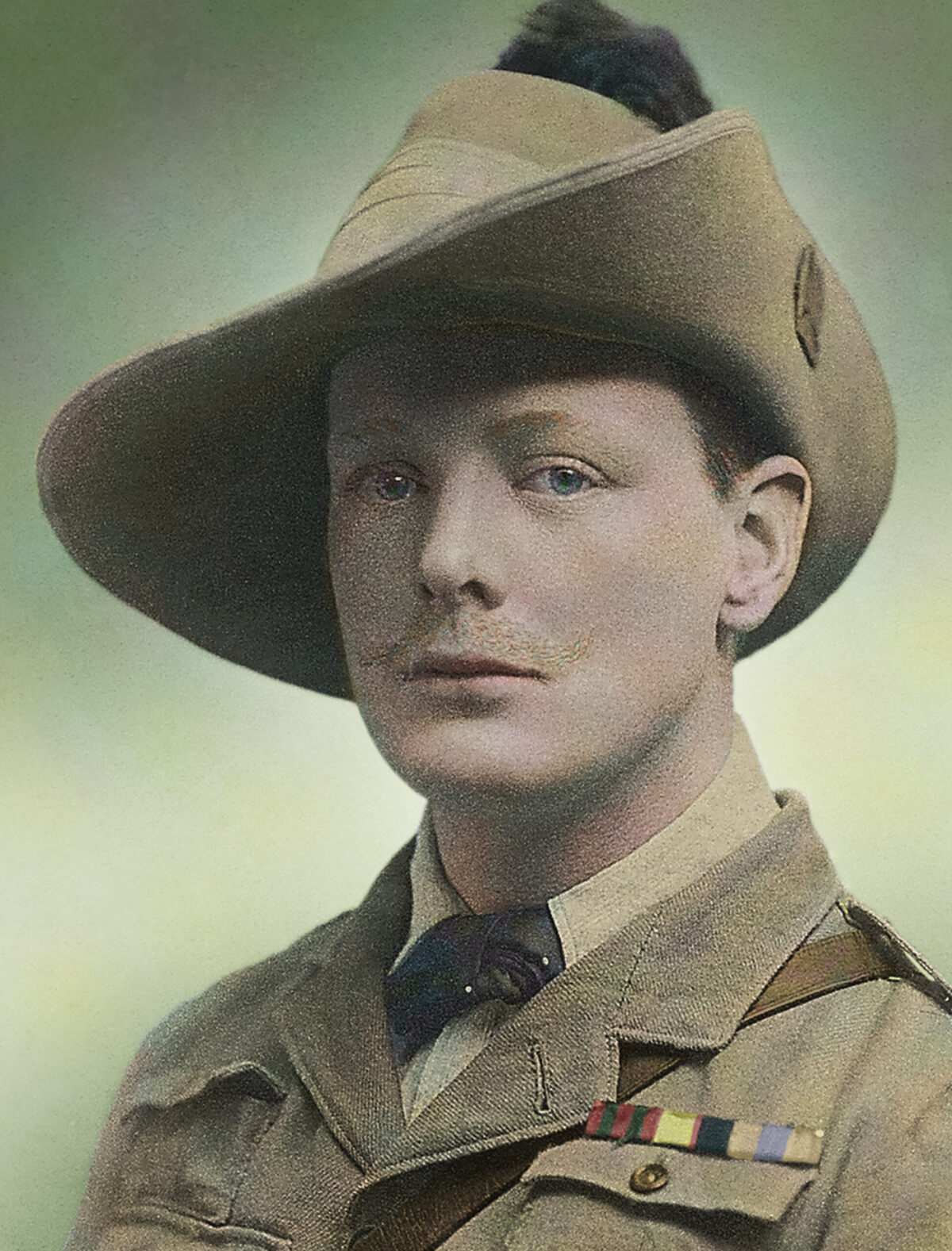Keep cool, men!” shouted Winston Churchill as Mauser bullets whizzed uncomfortably past him and violently struck the ground around him. It was Nov. 15, 1899, and the future cigar-smoking British prime minister was in the thick of a vicious firefight with a Boer commando. Churchill thrived on adventure and danger, and he appeared to witnesses on that fateful day to be in his element as he barked out orders to British soldiers.
The armored train in which Churchill had been riding had become victim of a well-executed Boer ambush, and the soldiers manning the train were now paying the heavy price of military incompetence. Many who survived the attack certainly had Churchill to thank for their lives. Yet this exciting incident was only the start of his escapades in Southern Africa.
By the time of the outbreak of the Second Boer War in 1899, Churchill had already left his military career behind him. He had earlier entered Royal Military Academy Sandhurst on his third attempt in September 1893. He was commissioned as a second lieutenant into the 4th Queen’s Own Hussars in February 1895, having passed out twentieth of 130.
Characteristically, Churchill had managed to embroil himself in a public controversy during his final term at Sandhurst. Mrs. Ormiston Chant, an eminent moral reformer of the day, had been actively campaigning for what she viewed as immoral women to be banned from the bar at the Empire Theatre of Varieties in Leicester Square, London. As a compromise, screens had been erected to separate these “fallen women” from normal theatregoers, which Churchill, while inciting several of his fellow cadets to join him, pulled down in wild protest. This boisterous little riot prompted Churchill to spontaneously exclaim, “Ladies of the Empire, I stand for Liberty!”
Churchill’s first experience of shots fired in anger did not, as one might expect, come as a consequence of his service in the British Army. He had travelled to Cuba as a correspondent for the Daily Graphic newspaper to get shot at. It was on Nov. 30, 1895—his 21st birthday—that Churchill heard these first shots while accompanying Spanish forces attempting to put down a rebellion. Afterwards, Churchill said, “Nothing in life is so exhilarating as being shot at without result!” It is said that during his time in Cuba, Churchill acquired his two lifelong habits of smoking fat cigars and taking afternoon siestas.
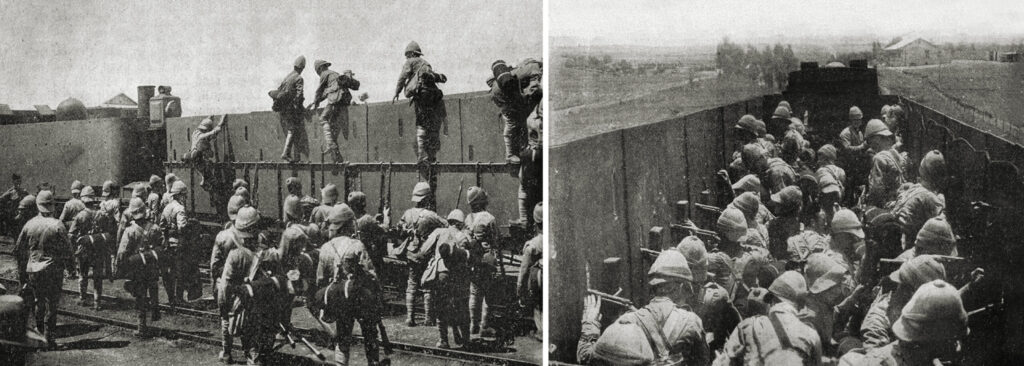
In October 1896, Churchill traveled with his regiment to India, where he saw action as part of Brig. Gen. Sir Bindon Blood’s Malakand Field Force during the Northwest Frontier risings of 1897. That year, Churchill published his first book, The Story of the Malakand Field Force, based on his experiences. In summer 1898, he managed, despite strong objections from Herbert Kitchener, to take part in the closing stages of the campaign in Sudan, doubling as a correspondent for the Morning Post.
It was during the climactic Battle of Omdurman on Sept. 2 that Churchill took part in the epic but disastrous charge of the 21st Lancers, shooting dead at least three of his enemy at point-blank range with his C96 “Broomhandle” Mauser pistol.
Luckily for Churchill, prior to the battle he had injured his sword hand and had thus armed himself in the charge with his Mauser pistol. It clearly saved his life when he was cut off and surrounded by several Mahdists whom he then dispatched with his pistol—had he only a sword, they would surely have killed him.
Again, he wrote a book about his experiences, publishing the two-volume The River War in 1899. Military service, however, was viewed by Churchill as a means of getting on in politics. As such, he resigned his commission in 1899 to campaign for election to Parliament.
That same year, however, Britain began fighting its most challenging colonial war of the Victorian era—a conflict that young Churchill was determined not to miss at any cost.
The causes of the conflict between the Boers and the British interlopers in South Africa are deeply rooted, complex, and remain debated by historians to this day. A key issue lay in the desire to control gold mining in Witwatersrand within the borders of the Boer South African Republic (SAR). At that time much of the world’s monetary systems were underpinned by gold reserves, and Witwatersrand was then the largest gold mining operation in the world. Although located within Boer territory, many Uitlanders (non-Boer “outlanders”) working in the gold mining industry were British.

Alfred Milner, the British High Commissioner for South Africa, sought to use the British Uitlanders to exert influence over the SAR. In 1897, he demanded that the Boer leaders of the republic modify their constitution to grant the Uitlanders political rights. Because the British Uitlanders were so numerous, this would effectively allow Milner to dominate SAR government policy.
Perhaps unsurprisingly, Paul Kruger, the President of the republic, was not keen to grant virtual political control to the British. Marthinus Steyn, the President of the Boer Orange Free State, organised a conference at Bloemfontein (May–June 1899) between Milner and Kruger in the hope of averting potential conflict. Kruger agreed to some concessions but Milner inevitably rejected them out of hand for not going far enough.
To force the matter, Milner requested London send additional British troops to South Africa, who began arriving in August and September 1899. The arrival of these troops caused great alarm amongst the Boers. The Boers now believed war was inevitable and reasoned that it would be to their advantage to take to the offensive before the British. On Oct. 9, 1899, the Boers delivered an ultimatum to the British, demanding they withdraw their troops or face war. The British unsurprisingly refused to comply. On Oct. 11 the Second Boer War began.
Meanwhile, Churchill had narrowly lost the Oldham by-election on July 6, 1899. He later viewed the defeat as fortunate, since he was free to travel to South Africa following the war’s outbreak. The capacity in which Churchill went to South Africa was again as a war correspondent for the Morning Post. The newspaper offered to pay him the huge sum of £1,000 for the first four months, followed by £200 a month plus expenses for subsequent months.
With his finances arranged, Churchill boarded the RMS Dunottar Castle for the voyage to Cape Town. Also onboard was Gen. Sir Redvers Buller, who would initially command British troops in South Africa.
Like many others at the time, Churchill did not believe the Boers would last long in a fight with the British. Indeed, he believed he would be home before the Derby horserace at the end of May 1900. Such confidence appeared justified to Churchill when the Dunottar Castle passed by a small tramp steamer that was three days out of Cape Town. Displayed on the steamer was a chalk board, upon which was written the message, “Boers Defeated—Three Battles—Penn Symons Killed.” Other than the fact Gen. Sir William Penn Symons had died—he had been mortally wounded at the Battle of Talana Hill—the news appeared so positive that Churchill worried he would miss the action before he got to Cape Town. However, the war soon began to go badly for the British.
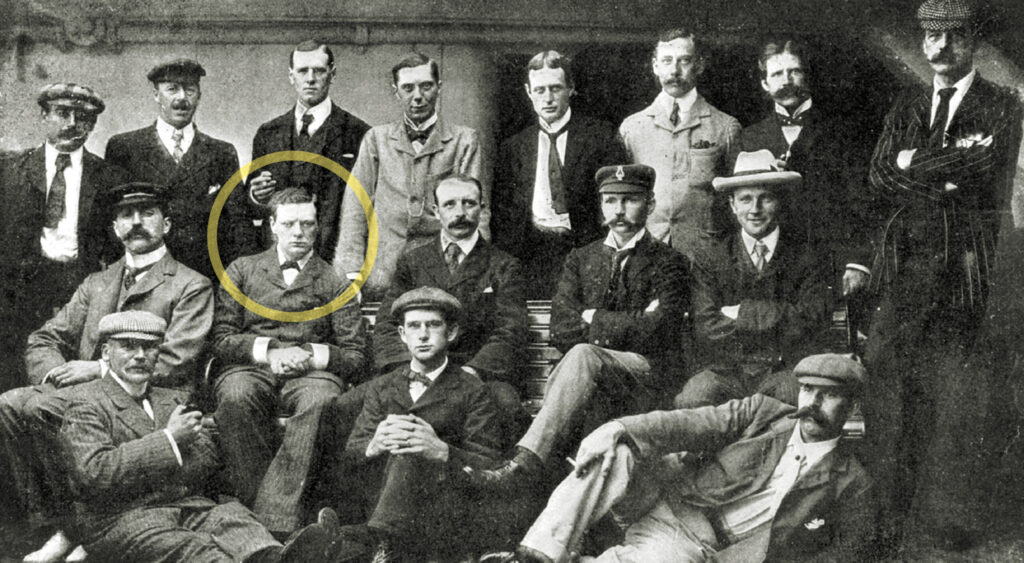
When Churchill landed at Cape Town, he immediately attempted to make his way to Ladysmith. By Nov. 2, however, the town was under siege by the Boers. Again, Churchill’s misfortune turned into a positive. Had he reached Ladysmith before the siege began, he would have been stranded there for months. Instead, he opted to make for Estcourt, where he hoped to bide his time before joining British forces sent to relieve Ladysmith.
Early on the morning of Nov. 15, 1899, Col. Charles Long, commander of British forces at Estcourt, instructed Capt. Aylmer Haldane to take an armoured train and conduct a patrol. Onboard the three trucks that made up the train were men of the Dublin Fusiliers and Durham Light Infantry. Also placed in one of the trucks was a 7-pounder naval gun. This was a small, rifled, “mountain howitzer” in British Army use from 1866 through the end of the Second Boer War and often described as “mounted on armored trains.” The projectile weighed only 7 lbs, making it a very small artillery weapon. The ever-enthusiastic Churchill jumped at the chance to accompany the patrol. It was a fateful decision that would have a major impact on his life. Haldane spotted some Boers on the journey out, but Churchill persuaded the captain to push on with the patrol and not turn back.
As the train thundered north toward Chieveley, a Boer commando discretely watched. The Boers surreptitiously placed rocks on the tracks after a bend near the Blaauwkrantz River in the hope of stopping the train on its return journey. When the Boers opened fire on the train, the engineer reversed at full throttle, falling into the Boer trap. The train violently smashed into the rocks, incredibly remaining on the tracks, though the the impact derailed several trucks.
At that moment, the Boers increased the volume of their artillery and rifle fire. The naval gun was quickly put out of action. Although Churchill was partly to blame for the train lumbering into the Boer trap, he sprang into action and displayed reckless courage under fire.
Churchill got some of the dazed soldiers out of the derailed trucks and organised them to start heaving them off the track to free the engine. He was heard to say, “This will be interesting for my paper.” Even under fire Churchill was thinking about his writing.
When a bullet grazed the head of the engineer, Charles Wagner, Churchill quickly intervened to prevent the man from running off, saying to him, “No man is hit twice on the same day.” With the engine freed, about 40 to 50 wounded men were crammed into the train’s locomotive before it steamed off as the unwounded soldiers ran beside it, using the locomotive to block Boer fire. Wagner, however, decided that to save the wounded he’d have to race back to Estcourt at full throttle, thereby leaving the soldiers on foot to fend for themselves.
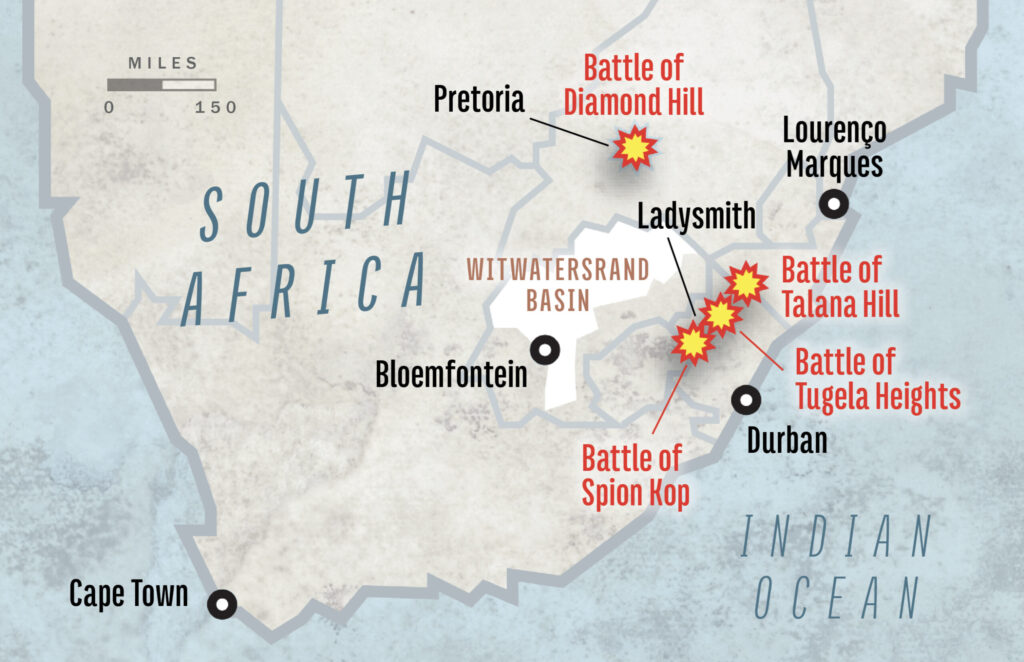
As the engine departed, Churchill rallied the remaining soldiers in their fight against the Boers. The British were greatly outnumbered and taking casualties. Little option remained but to surrender, and the survivors were taken prisoner by the Boers. Haldane and 56 of his men were captured, thirty of them wounded. At least four others had been killed during the ambush. Churchill, a civilian and no longer a soldier, had left his Mauser pistol on the train. Again, what might have been a misfortune turned to his advantage—if he had been taken prisoner while armed, he may have been treated very differently by his captors and had he tried to shoot his Boer pursuers, they surely would have shot him dead.
Following his capture, Churchill argued for his release since he was a civilian. However, because he was seen giving orders and behaving like a combatant during the train ambush, the Boers decided to imprison him. He was transferred to the State Model School Prison in Pretoria. The life of a prisoner of war was particularly difficult for Churchill. He was not a man who tolerated being restricted. He would later write: “Hours crawl like paralytic centipedes. Nothing amuses you. Reading is difficult, writing, impossible. I certainly hated every minute of my captivity more than I have ever hated any period of my life.” Nevertheless, he found some solace in studying butterflies and writing letters.
It is hardly surprising then, that Churchill sought to escape and return to British lines. On Dec. 12, when the Boer guards were not looking, Churchill climbed over the prison fence behind the lavatory. Several other prisoners, including Haldane and Sgt. Maj. Adam Brockie, were also present for the escape attempt. However, both Haldane and Brockie seemed to hesitate, much to Churchill’s annoyance.
He later wrote: “I jumped on to the ledge of the wall and in a few seconds had dropped into the garden safely on the other side. Here I crouched down and waited for the others [Haldane and Brockie] to come. I expected them to come every minute. My position in the garden was a very anxious one because I had only a few small and leafless bushes to hide behind, and people kept passing to and fro, and the lights of the house were burning. Altogether I waited more than an hour and a half in the garden for the others to join me.”
Churchill later claimed that Haldane and Brockie urged him to return, but he had refused. When they realized he was not going to return, they gave Churchill their blessing.
Now out of prison, Churchill found himself nervously wandering through the streets of Pretoria. He reasoned that he would need to make his way to neutral Portuguese East Africa. However, that was a 300-mile journey, for which he had no map, no compass, no food, and no water. Worst of all, he could not speak Afrikaans, the Boers’ Dutch-based language. Having made his way through Pretoria, remarkably without being spotted, he managed to climb aboard a coal train, hiding himself amongst the coal sacks. Unfortunately, it turned out that the train was going in the wrong direction, and so he was forced to jump off.
Hungry and lost, Churchill decided he needed to take the risk of finding someone to aid him in his escape. He knocked on a farmhouse door at a kraal (livestock enclosure typical of Boer or native African farms/stock-raisers and small villages) and to his pleasant surprise an Englishman by the name of John Howard answered.
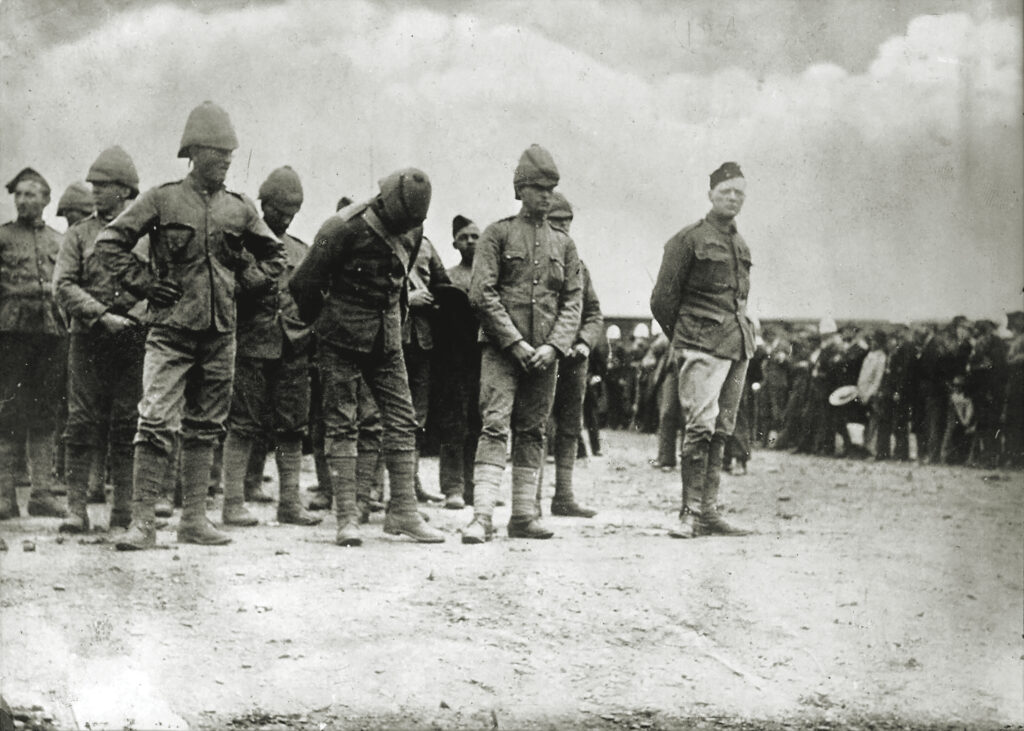
Howard was a mining engineer, and he led Churchill into one of his mines to hide him. After three days there, Churchill found himself put into the bottom of a railway coal wagon bound for Lourenço Marques, the capital of Portuguese East Africa. Once he finally arrived on Dec. 22, he was taken to the British Consul by some local British inhabitants. He then took a hot bath and was given clean clothes. Churchill was upset to learn his original dirty clothes had been burned, because, as he later boastfully wrote, “I wanted them for Madame Tussaud” (founder of the famed wax museum in London).
Leaving Lourenço Marques, Churchill took a boat to Durban, where he was welcomed by a large and enthusiastic crowd who had learned of his spectacular escape. As one might expect of Churchill, he then gave an impromptu speech to the crowd, which was rapturously received.
The war had gone particularly badly for the British between Dec. 10 and 15, during which they suffered high casualties in what became known as “Black Week.” It was now clear that the Boers were not going to be as easily defeated as Churchill had once thought, and the war would last longer. Churchill was now offered a commission in the South African Light Horse by Buller. The position was unpaid, but Buller allowed Churchill to continue his war correspondent work in order to receive pay. Churchill then returned to the war as a soldier. Almost immediately he was back to risk-taking when he volunteered to take a message from Col. Julian Byng to Maj. Gen. Sir Francis Clery, the latter almost 20 miles away with unknown numbers of Boers in between.
Churchill boldly told Byng that he wanted to win the Distinguished Service Order, because he thought it would one day look good on his robes as Chancellor of the Exchequer. To this, Byng replied, “he must first get into Parliament, if he could get any constituency to have him!” Nevertheless, Churchill was adamant that he would have his choice of constituencies upon his return home. He was now a war hero, after all.
On Jan. 23-24, 1900, Churchill was present at the Battle of Spion Kop, which ended in disaster for the British as 8,000 Boers defeated 20,000 British soldiers. His role was to act as messenger between Gen. Sir Charles Warren and Col. Alexander Thorneycroft. The battle was poorly managed by senior British officers—with Thorneycroft even leading an assault up the wrong hill. As Churchill witnessed this poor example of command, a bullet scraped the feathers on his hat.
The following month, on Feb. 12, Churchill was accompanied by his 20-year-old younger brother Jack, who was also serving in the South African Light Horse, on reconnaissance during the Battle of the Tugela Heights. Jack was shot through the leg. Of his brother’s wounding, Churchill later wrote: “Outwardly I sympathised with my brother in his misfortune, which he mourned bitterly, since it prevented him taking part in the impending battle, but secretly I confess myself well content that this young gentleman should be honourably out of harm’s way for a month.” Churchill would be present during the relief of Ladysmith on Feb. 28 (besieged by the Boers since November 2, 1899). He finally got to the destination that he had been so eager to reach upon his first arrival in South Africa. He later wrote in his 1930 book, My Early Life, of this moment: “On we pressed, and at the head of a battered street of tin-roofed houses met [Lieutenant General] Sir George White on horseback, faultlessly attired. Then we all rode together into the long beleaguered, almost starved-out, Ladysmith. It was a thrilling moment. I dined with the Headquarters staff that night.”
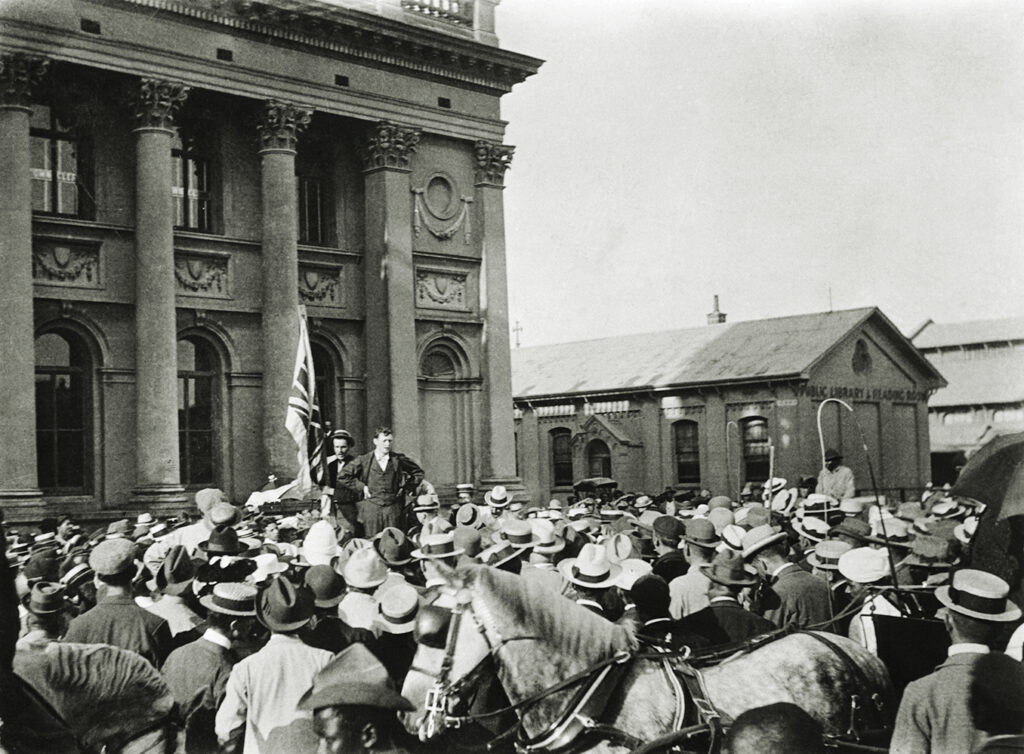
In May 1900, Churchill would have yet another book published, this time about his experiences in South Africa, called London to Ladysmith via Pretoria. His subsequent Boer War adventures included entering Pretoria with his unit on June 5, and liberating those still held in the same prison in which he had himself been interned. He was also present at the Battle of Diamond Hill on June 11-12. Gen. Ian Hamilton later stated that Churchill showed “conspicuous gallantry” during the battle and tried to get him a gallantry award, but it was denied because of Churchill’s principal status as a war correspondent.
Nevertheless, Churchill had quite the experience during his time in South Africa. The war itself would drag on until May 31, 1902, but Churchill now thought it time to return home. He now felt ready for a life in politics.
Churchill arrived back in Britain on July 20, 1900 and was welcomed home not only a war hero but also as a national hero. As he had expected, he was asked to stand for election for no fewer than 11 Conservative constituencies. However, he decided to stand at Oldham, where he had been defeated before the war. On Oct. 1, he narrowly won one of the two seats for Oldham, beating a rival by only 392 votes.
By the time Churchill finally sat in the House of Commons, he had served in four wars. He had taken part in one of the most famous cavalry charges in history, escaped from prison, published five books, and written more than 200 newspaper and magazine articles. Born Nov. 30, 1874, he was still about two months short of his 26th birthday when elected to Parliament on Oct. 1, 1900.

